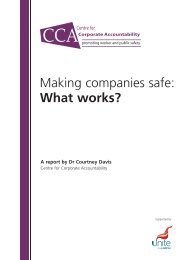Manual Handling Manual Handling Operations Regulations 1992 ...
Manual Handling Manual Handling Operations Regulations 1992 ...
Manual Handling Manual Handling Operations Regulations 1992 ...
You also want an ePaper? Increase the reach of your titles
YUMPU automatically turns print PDFs into web optimized ePapers that Google loves.
Health and Safety<br />
Executive<br />
Guidance<br />
4(1)(b)(iii)<br />
Regulation<br />
175 The <strong>Regulations</strong> impose duties on employers whose employees carry out<br />
manual handling. However, those who originate loads that are likely to undergo<br />
manual handling may also have relevant duties, for example under sections 3 or<br />
6 of the HSW Act, for the health and safety of other people at work. They should<br />
make loads as easy to grasp and handle as possible, and mark loads clearly<br />
with their weight and, where appropriate, an indication of their heaviest side (see<br />
paragraphs 149-152).<br />
(2) Any assessment such as is referred to in paragraph (1)(b)(i) of this<br />
regulation shall be reviewed by the employer who made it if –<br />
(a)<br />
(b)<br />
there is reason to suspect that it is no longer valid; or<br />
there has been a significant change in the manual handling operations to<br />
which it relates;<br />
4(2)<br />
Guidance<br />
4(2)<br />
Regulation<br />
and where as a result of any such review changes to an assessment are required,<br />
the relevant employer shall make them.<br />
Reviewing the assessment<br />
176 The assessment should be kept up to date. It should be reviewed if new<br />
information comes to light or if there has been a change in the manual handling<br />
operations. The assessment should also be reviewed if a reportable injury occurs<br />
or when individual employees suffer an illness, injury or the onset of disability which<br />
may make them more vulnerable to risk.<br />
(3) In determining for the purposes of this regulation whether manual<br />
handling operations at work involve a risk of injury and in determining the<br />
appropriate steps to reduce that risk regard shall be had in particular to:<br />
4(3)<br />
(a)<br />
(b)<br />
(c)<br />
(d)<br />
(e)<br />
(f)<br />
the physical suitability of the employee to carry out the operations;<br />
the clothing, footwear or other personal effects he is wearing;<br />
his knowledge and training;<br />
the results of any relevant risk assessment carried out pursuant<br />
to regulation 3 of the Management of Health and Safety at Work<br />
<strong>Regulations</strong> 1999;<br />
whether the employee is within a group of employees identified by that<br />
assessment as being especially at risk; and<br />
the results of any health surveillance provided pursuant to regulation 6 of<br />
the Management of Health and Safety at Work <strong>Regulations</strong> 1999.<br />
Guidance<br />
Individual capability<br />
Physical suitability of the employee<br />
Does the task require unusual strength, height etc?<br />
177 The ability to carry out manual handling safely varies between individuals.<br />
These variations, however, are less important than the nature of the handling<br />
operations in causing manual handling injuries. Assessments which concentrate<br />
on individual capability at the expense of task or workplace design are likely to be<br />
misleading. (Employers should also be aware of their duties under the Disability<br />
Discrimination Act 1995, 17 particularly section 6.)<br />
4(3)(a)<br />
178 In general the lifting strength of women is less than that of men. But for both<br />
men and women the range of individual strength and ability is large, and there is<br />
considerable overlap – some women can safely handle greater loads than some<br />
men.<br />
<strong>Manual</strong> handling Page 40 of 90
















